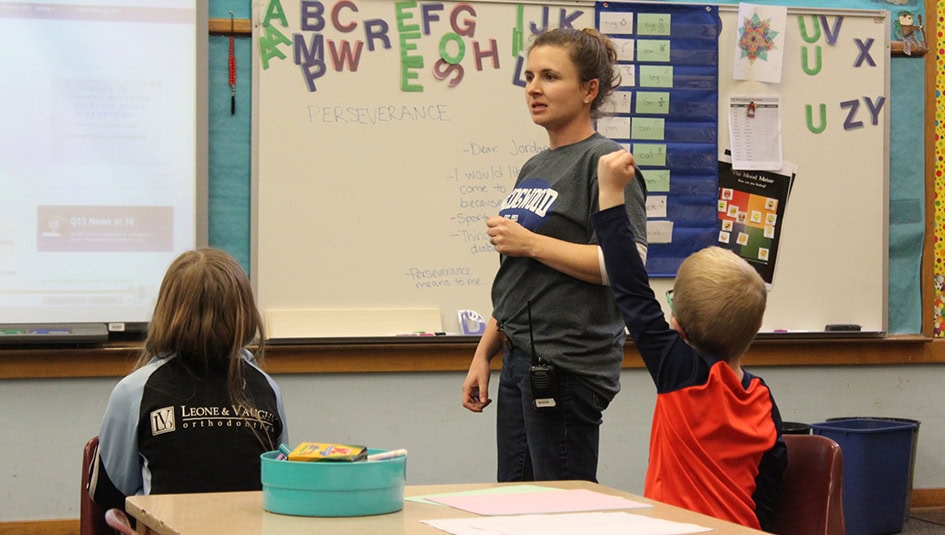The School Nurse Who Cares for 8 Kids with Type 1

My six-year-old son, Peter, was diagnosed with Type 1 diabetes two days before his third birthday. About a year later, my wife and I moved our family across town so Peter could start kindergarten in an elementary school with a full-time nurse.
At the time, our idea of a school nurse was pretty, well, elementary. In our minds, the nurse was a health care provider who happened to be doing business in an educational setting. It never occurred to us that the nurse could be an integral part of the education itself.
Read “When the School Nurse Won’t Help with Your Child’s Pump.”
Over the last year, Peter’s school nurse, Sarah Barquero (aka Nurse Sarah) has become a pivotal part of our daily lives. I sat down with Nurse Sarah recently to talk about how she sees her role as an educator, and about an important extra step she has taken in her job that has changed the way Peter thinks about diabetes and himself.
Nurse Sarah has an unusual patient portfolio. At our school, Wedgwood, Peter is one of eight kids with Type 1 diabetes; it is the largest concentration of kids with Type 1 in any Seattle public elementary school. That’s a lot of pods, CGMs, and carb counts to manage. In the spring of 2015, after comparing notes with Anna Barash, another school nurse, Barquero decided to create a diabetes group in her school.
Read “What if the School Nurse is Busy?”
“I wanted to do something for the T1 kids,” Barquero explains. “I wanted them to be able to talk to each other in a supportive environment so that diabetes becomes more normalized in school.”
To her knowledge, the Wedgwood diabetes group is the only one of its kind in the district, which serves more than 53,000 students. The group, with an age range of six to ten years, is less of a support group and more of a learning space for kids who are figuring out how to navigate life with diabetes.
“My first goal for every kid is to get them as independent as they can be for their age,” says Barquero. “With fourth-graders we talk about good snack choices for lows so they can check their blood sugar in the classroom. For a kindergartner, it’s obviously different. Just watching a six-year-old learn to take his own blood sugar and tell me what he’s going to do… that’s huge.”
Coaching a six-year-old to check his own blood sugar is an achievement on its own. But Nurse Sarah’s diabetes group is also a way for the students to think practically about the unpredictable, real-world situations that are an inescapable part of Type 1 Diabetes.
“It breaks my heart if one of the kids comes in and can’t go outside to recess because their blood sugar is too low,” she says. “So we talk about what we could do instead. Can I come out with you so there is someone watching you until your blood sugar goes back up? Could you be the referee in the game for a few until you’re ready to play?”
The group also gives the kids a chance to feel normal.
![]() “Most kids just want to fit in with their peers,” says Nurse Sarah. “Anything, like diabetes, that singles them out makes that hard in a social setting. I watch the kids pull out their pods and show each other and it doesn’t faze them like it might in the classroom, where they might look around first to see who’s watching. I see the younger kids watch the older kids and I imagine a kindergartner thinking, ‘Wow, there are seven other kids just like me in this school.’ I think that’s pretty powerful.”
“Most kids just want to fit in with their peers,” says Nurse Sarah. “Anything, like diabetes, that singles them out makes that hard in a social setting. I watch the kids pull out their pods and show each other and it doesn’t faze them like it might in the classroom, where they might look around first to see who’s watching. I see the younger kids watch the older kids and I imagine a kindergartner thinking, ‘Wow, there are seven other kids just like me in this school.’ I think that’s pretty powerful.”
As parents, our hearts leapt when Peter came home one day and checked his own blood sugar. It happened again when he led a show-and-tell on diabetes in front of his entire first-grade class. This is the full picture of health, the sweet spot where healthy body chemistry is joined with an empowered, confident mind.
In a statement entitled The Role of the 21st Century Nurse, the National Association of School Nurses describes how the school nurse “serves in a pivotal role that bridges health care and education.” An article in the association’s journal, School Nurse, ties this goal specifically to Type 1 diabetes management in a school setting: “Ongoing diabetes self-management education and support is critical to helping youth with diabetes.” The article emphasizes that “school nurses are an important part of the student’s diabetes healthcare team.”
The reality is fewer than half of all public schools even have a full-time nurse. We don’t just have a nurse; we have a true partner in our son’s school diabetes management. I’m hesitant to call any child living with Type 1 Diabetes lucky, but, in this case, I believe that’s exactly the word to describe the students under Nurse Sarah’s students care. We wish this kind of care for every child with Type 1 in school.
Thanks for reading this Insulin Nation article. Want more Type 1 news? Subscribe here.
Have Type 2 diabetes or know someone who does? Try Type 2 Nation, our sister publication.